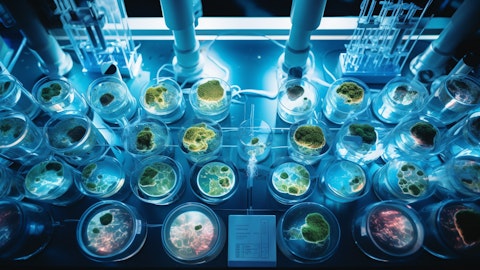ChipMOS TECHNOLOGIES Inc. (NASDAQ:IMOS) Q2 2025 Earnings Call Transcript August 12, 2025
ChipMOS TECHNOLOGIES Inc. reports earnings inline with expectations. Reported EPS is $0.1923 EPS, expectations were $0.1923.
Operator: Greetings, and welcome to the ChipMOS Second Quarter 2025 Results Conference Call. [Operator Instructions] I would now like to turn the conference over to Dr. G. S. Shen of ChipMOS Technologies Strategy and Investor Relations team to introduce the management team of the company in conference. Dr. Shen, you may begin.
G. S. Shen: Thank you, operator. Welcome, everyone, to ChipMOS Second Quarter 2025 Results Conference Call. Joining us today from the company are Mr. S.J. Cheng, Chairman and President; and Ms. Silvia Su, Vice President of Finance and Accounting Management Center. We are also joined on the call today by Mr. Jesse Huang, Spokesperson and Senior Vice President of Strategy and Investor Relations. S.J. will chair the meeting and review business highlights and provide more color on the operating environment. After Silvia’s review of the company’s key financial results, S.J. will provide our current business outlook. All company executives will then participate in an open Q&A session. Please note, we have posted a presentation on the MOPS and also on the ChipMOS website, www.chipmos.com, to accompany today’s conference call.
Before we begin the prepared comments, we remind you to review our forward-looking statements disclaimer, which is noted as the safe harbor notice on the second page of today’s presentation and in the results press release we issued. As a reminder, today’s conference call is being recorded, and a replay will be made available later today on the company’s website. At this time, I’d like to now turn the call over to our company’s Chairman and President, Mr. S.J. Cheng. Please go ahead, sir.
Shih-Jye Cheng: Yes. Thank you, G.S. We appreciate everyone joining our call today. Second quarter results came in as expected with strong memory product demand offsetting macro softness in auto and industrial and the higher NTD headwind. We continue to leverage our leadership position as we build long-term value for shareholders, and we will remain conservative in our CapEx spending as we keep our balance sheet strong. We are prioritizing supporting our customers, increasing market share, expanding profitability and building shareholder value. In terms of Q2 highlights, our revenue increased 3.7% compared to Q1. Q2 gross margin was 6.6%, which decreased 280 basis points compared to Q1. Q2 net losses were TWD 0.75 per share due to higher foreign exchange loss of approximately TWD 0.97 per share.
In terms of the details, our overall utilization rate was 65% in Q2 with an improvement in memory products. The assembly UT was up to 64% and the average test utilization was also up to 67% in Q2. Regarding DDIC was 66% and bumping was 63%. Regarding our manufacturing business, assembly represented 27.9% of Q2 revenue led by a recovery in our memory products. Mixed signal and memory testing represented 23.9% and wafer bumping represented 23.2% of Q2 revenue. On a product basis, our DDIC product represented 23.5% of total revenue in Q2, with gold bumping representing about 21.2% of Q2 revenue. Revenue from DRAM and SRAM represented 16.3% of Q2 revenue. Our mixed signal products represented 10% of Q2 revenue. As additional color, our memory products represented 45.3% of Q2 revenue.
Memory product revenue increased 21.2% compared to Q1 and increased 17.6% on a year-over-year basis. This benefited from pricing and volume. DRAM represented 15.7% of Q2 revenue and significantly increased 19.8% compared to Q1. Niche DRAM also significantly increased 29.3% compared to Q1. Flash revenue represented about 29% of Q2 revenue, which was up 21.7% compared to Q1 and was up 23.1% on a year-over-year basis. NAND Flash represented 39.6% of our Q2 Flash revenue. This is up 27.6% compared to Q1 and significantly increased around 40% on a year-over-year basis. NOR Flash increased 25.3% compared to Q1 and increased 21.2% on a year-over-year basis. Moving on to Driver IC and Gold Bump revenue. This represented about 44.7% of Q2 revenue. Headwinds included ASP and foreign exchange with revenue down 9.4% compared to Q1 and down 17.9% on a year-over-year basis.
Of note, Gold Bump revenue decreased 7.6% compared to Q1 and was up 11% on a year-over-year basis. Our DDIC revenue was down 10.9% compared to Q1. Demand related to auto panels contributed more than 32% of our Q2 DDIC revenue, which down about 13.9% compared to Q1. Regarding OLED, this represented about 24.5% of our Q2 DDIC revenue and decreased 14.7% compared to Q1. On an end market basis, total revenue from automotive and industrial represented about 25.9% of Q2 revenue. This was about 1% lower than Q1. Smartphone revenue represented 37.4% of Q2 revenue and was up 7.3% compared to Q1. TV panel demand represented 11.8% of Q2 revenue, which was down 13.8% compared to Q1. Consumer-related revenue represented 20.8% and computing accounted for 4.1% of Q2 revenue, respectively.
Now let me turn the call to Ms. Silvia Su to review the second quarter 2025 financial results. Silvia, please go ahead.
Silvia Su: Thank you, S.J. All dollar amounts cited in our presentation are in NT dollars. The following numbers are based on the exchange rates of TWD 29.18 against USD 1 as of June 30, 2025. All the figures were prepared in accordance with Taiwan International Financial Reporting Standards. Referencing presentation, Page 12, consolidated operating results summary. For the second quarter of 2025, total revenue was TWD 5,736 million. Net loss attributable to the company was TWD 533 million in Q2. Net losses for the second quarter of 2025 were TWD 0.75 per basic common share or USD 0.51 per basic ADS. EBITDA for Q2 was TWD 1,302 million. EBITDA was calculated by adding depreciation and amortization together with operating profit.

Return on equity in Q2 was minus 8.8%. Referencing presentation, Page 13, consolidated statements of comprehensive income. Compared to Q1 2025, total Q2 2025 revenue increased 3.7% compared to Q1 2025. Q2 2025 gross profit was TWD 379 million with gross margin at 6.6% compared to 9.4% in Q1 2025. Our operating expenses in Q2 2025 were TWD 424 million or 7.4% of total revenue, which increased 3.2% compared to Q1 2025. Operating profit for Q2 2025 was TWD 21 million, with operating profit margin at 0.4% compared to 2.1% in Q1 2025. Net nonoperating expenses in Q2 2025 was TWD 682 million compared to net nonoperating income in Q1 2025 was TWD 82 million. The difference is mainly foreign exchange, which went from a gain of TWD 62 million in Q1 2025 to a loss of TWD 690 million in Q2 2025.
We expect this to have less of an impact in Q3. Loss attributable to the company in Q2 2025 was TWD 533 million compared to profit attributable to the company in Q1 2025 was TWD 176 million. The difference is mainly due to an increase of net nonoperating expenses of TWD 764 million and a decrease of operating profit of TWD 95 million, which was offset by the income tax change of TWD 150 million from the income tax expense of TWD 22 million in Q1 2025 to income tax benefit of TWD 128 million in Q2 2025. Basic weighted average outstanding shares were 715 million shares. Compared to Q2 2024, total revenue for Q2 2025 decreased 1.3% compared to Q2 2024. Gross margin at 6.6% decreased 7.4 ppts compared to Q2 2024. Operating expenses decreased 7.8% compared to Q2 2024.
Operating profit margin at 0.4%, decreased 6.0 ppts compared to Q2 2024. Net nonoperating expense in Q2 2025 was TWD 682 million compared to net nonoperating income in Q2 2024 was TWD 128 million. The difference is mainly due to the negative impact on the foreign exchange of TWD 715 million from the foreign exchange gains of TWD 25 million in Q2 2024 to the foreign exchange losses of TWD 690 million in Q2 2025 and the gain on disposal of noncurrent assets held for sale of TWD 72 million in Q2 2024. Loss attributable to the company in Q2 2025 was TWD 533 million compared to profit attributable to the company in Q2 2024 was TWD 451 million. The difference is mainly due to an increase of net nonoperating expense of TWD 810 million and the decrease of operating profit of TWD 353 million, which was offset by the income tax change of TWD 179 million from the income tax expense of TWD 51 million in Q2 2024 to income tax benefit of TWD 128 million in Q2 2025.
Referencing presentation, Page 14, consolidated statements of financial position and key indices. Total assets at the end of Q2 2025 were TWD 43,521 million. Total liabilities at the end of Q2 2025 were TWD 20,265 million. Total equity at the end of Q2 2025 was TWD 23,256 million. Accounts receivable turnover days in Q2 2025 were 87 days. Inventory turnover days was 50 days in Q2 2025. Referencing presentation, Page 15, consolidated statements of cash flows. As of June 30, 2025, our balance of cash and cash equivalents was TWD 13,662 million, which represents a decrease of TWD 1,557 million compared to the beginning of the year. Net free cash inflow for the first half of 2025 was TWD 1,667 million compared to TWD 1,433 million for the same period in 2024.
The difference is mainly due to the decrease of CapEx of TWD 332 million, the income tax change of TWD 238 million from the income tax expense of TWD 132 million in the first half of 2024 to income tax benefit of TWD 106 million in the first half of 2025. The increase of the depreciation expenses of TWD 224 million and partially offset by the decrease of operating profit of TWD 600 million. We continue to balance our capital allocation strategy by investing in the long-term capacity and revenue generation areas that will drive our success while returning value to shareholders through the distribution of dividends. Free cash flow was calculated by adding depreciation, amortization, interest income together with operating profit and then subtracting CapEx, interest expense, income tax expense and dividend from the sum.
Referencing presentation, Page 16, capital expenditures and depreciation. We invested TWD 589 million in CapEx in Q2. The breakdown of CapEx in Q2 was 20.1% for Bumping, 31.6% for LCD driver, 20.1% for assembly and 28.2% for testing. Depreciation expenses were TWD 1,281 million in Q2. As of July 31, 2025, the company’s outstanding ADS number was approximately 3.6 million units, which represents around 10.1% of the company’s issued common shares. That concludes the financial review. I will now turn the call back to our Chairman, Mr. S.J. Cheng, for our outlook. Please go ahead, sir.
Shih-Jye Cheng: Thank you, Silvia. As we look ahead to Q3, we expect cautious end consumer demand given the global economic uncertainty and the early restocking of some consumer products in first half. However, we are encouraged by the strong demand from data center and communications, AI-enhanced products, auto and robotics. We expect this to increasingly benefit our business in the second half of the year and beyond. We also expect to benefit from solid memory product momentum in the second half of the year. There is a DDR4 and MLC NAND supply and demand imbalance led by DDR4 and MLC NAND EOL that will benefit our business. In addition, the solid DRAM and NAND products momentum growth is expected to help improve related UT levels of assembly and test.
ROM momentum is also expected to improve in Q3, led by seasonal restocking. Therefore, we expect memory momentum will be better than DDIC in Q3. In the meantime, we expect memory products OSAT price increases could help offset material cost increases and improve profitability. In our DDIC product business, we expect demand weakness to remain in Q3 with DDIC products still soft. However, OLED products momentum is expected to benefit from seasonal restocking in Q3. Meanwhile, automotive panel momentum is relatively stable compared to other DDIC products. We are positive about this business over the long term, but understand this is a fluid environment. Regarding our 2025 CapEx, we continue to shift our product mix into higher growth, higher-margin product areas.
We are taking a conservative approach with our CapEx budget in 2025, similar to prior years. Our targeted CapEx investments will be in support of growth areas of our business and to reduce depreciation pressure. Our strategy is not only expand in these higher growth, higher-margin areas, but to also benefit from continued cost reductions, quality improvement and operating strength actions to improve profit and maintain business growth momentum and competition advantage. Finally, as we remain focused on building value for shareholders, we just distributed our latest dividend to shareholders in July. This has been part of our overall capital allocation strategy along with share repurchases, CapEx investments and other levers. And we will execute the related capital allocation programs to improve shareholders’ equity based on the global economic environment and industrial situation.
These programs will be executed after Board approval. To summarize for you, we continue to leverage our leadership position in memory as we build long-term value for shareholders. Our balance sheet remains strong and is a competitive advantage for us. This gives us added flexibility to support our customers and our long-term growth strategy as we move through the near-term conservatism and uncertainty. We are taking a measured approach during this uncertain time, and we remain cautious in our CapEx spending. We will continue to prioritize supporting our customers, increasing market share, expanding profitability and building shareholder value. Operator, that concludes our formal remarks. We can now take questions.
Q&A Session
Follow Chipmos Technologies Inc (NASDAQ:IMOS)
Follow Chipmos Technologies Inc (NASDAQ:IMOS)
Receive real-time insider trading and news alerts
Operator: [Operator Instructions] Our first question comes from Michael Hsu from Yuanta.
Michael Hsu: Can you give us more color about the outlook by product for the second half of 2025?
Shih-Jye Cheng: As we look ahead to Q3, we expect to benefit from solid memory product momentum in the second half of the year. There is a DDR4 supply and demand imbalance led by DDR4 EOL and strong DDR5 demand that both will benefit our business. To reflect material cost and gold price increases, we also increased memory products OSAT prices in Q3 and expect it could help offset material cost increases and improve profitability. Therefore, we expect memory momentum will be better than DDIC in Q3. As for DDIC, OLED products momentum is expected to benefit from seasonal restocking in Q3. Meanwhile, automotive panel momentum is relatively stable compared to other DDIC products. Lastly, our logic and mixed signal product line should remain stable.
Michael Hsu: Please give us more color to separate the impact on lower Q2 gross margin from DDIC ASP cut and NTD appreciation. Will those conditions continue into Q3?
Shih-Jye Cheng: In Q2, gross margin was impacted by lower DDIC test ASP and USD depreciation. Meanwhile, the electricity charge increased TWD 102 million due to the higher summer electricity rate charge since May 16. The other factor was materials with the cost of gold increasing more than 30% compared to 2Q ’24. Regarding EPS, Silvia, please answer that question.
Silvia Su: More on your question for the impact to gross margin from foreign exchange rate and electricity. Gross margin decreased about 1.5 ppts due to NTD appreciation and decreased about 1.6 ppts due to higher electricity charges, which increased TWD 102 million due to the higher summer electricity rate. As for EPS, the major factor is the lower gross margin, including ASP cut and higher costs like electricity and separately, the higher foreign exchange loss of TWD 690 million.
Michael Hsu: Will those conditions continue into Q3?
Shih-Jye Cheng: We are increasing memory products OSAT prices in Q3 about 5% to 18% and expect it can help offset material cost increases from substrate and gold prices in order to improve profitability. Meanwhile, we expect the foreign exchange rate will be more favorable to our operations. Further, OLED product momentum is expected to be better. July revenue was announced and August revenue is on track. So even though there is still a lot of uncertainty, we are still optimistic entering Q3.
Operator: Thank you. And I am not showing any further questions in the queue. I would like to turn the call back over to G.S. Shen.
G. S. Shen: Thank you, operator. I will read one last question from foreign institutional investors. The question is, are you making a change to your dividend policy for 2026? Will you pay a dividend next year?
Shih-Jye Cheng: We just distributed our latest dividend to shareholders in July. This has been part of our overall capital allocation strategy along with share repurchases, CapEx investments and other levers. Although the company faced headwinds in the first half of the year, along with the broader industry, our focus and operational strength have put us in a great position with accumulated unappropriated retained earnings, which are sufficient to support a stable dividend payout. We do not expect any change in our policy, but our management and Board review the overall capital allocation strategy on a regular basis and remain cautious in our CapEx spending according to the market situation to set priorities in the best interest of the company and shareholders.
G. S. Shen: That concludes our question-and-answer session. Thank you for participating. I’ll turn the floor back to Mr. S.J. Cheng for any closing comments.
Shih-Jye Cheng: Thank you, everyone, for joining our conference call. Please e-mail our IR team if you have any more questions. We appreciate your support. Goodbye.
Operator: Ladies and gentlemen, this concludes today’s conference call. Thank you for participating. You may now disconnect. [Statements in English on this transcript were spoken by an interpreter present on the live call.]
Follow Chipmos Technologies Inc (NASDAQ:IMOS)
Follow Chipmos Technologies Inc (NASDAQ:IMOS)
Receive real-time insider trading and news alerts




